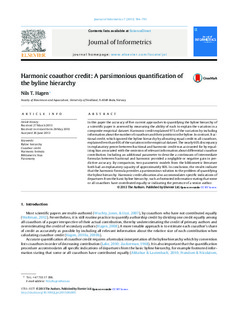Harmonic coauthor credit : A parsimonious quantification of the byline hierarchy
Journal article, Peer reviewed

Åpne
Permanent lenke
http://hdl.handle.net/11250/278744Utgivelsesdato
2013Metadata
Vis full innførselSamlinger
Originalversjon
Hagen, N.T. (2013). Harmonic coauthor credit: A parsimonious quantification of the byline hierarchy. Journal of Informetrics, 7(4), 784-791. doi: 10.1016/j.joi.2013.06.005Sammendrag
In this paper the accuracy of five current approaches to quantifying the byline hierarchy of a scientific paper is assessed by measuring the ability of each to explain the variation in acomposite empirical dataset. Harmonic credit explained 97% of the variation by including information about the number of coauthors and their position in the byline. In contrast, fractional credit, which ignored the byline hierarchy by allocating equal credit to all coauthors, explained less than 40% of the variation in the empirical dataset. The nearly 60% discrepancy in explanatory power between fractional and harmonic credit was accounted for by equalizing bias associated with the omission of relevant information about differential coauthor contribution. Including an additional parameter to describe a continuum of intermediate formulas between fractional and harmonic provided a negligible or negative gain in predictive accuracy. By comparison, two parametric models from the bibliometric literature both had an explanatory capacity of approximately 80%. In conclusion, the results indicate that the harmonic formula provides a parsimonious solution to the problem of quantifying the byline hierarchy. Harmonic credit allocation also accommodates specific indications of departures from the basic byline hierarchy, such as footnoted information stating that some or all coauthors have contributed equally or indicating the presence of a senior author.
